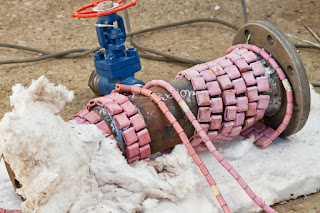 |
Welding between insulated heating areas
Heating done by ceramic heaters (pink). |
There are several key reasons why it's important to preheat before welding. First, a preheated part cools more slowly, which slows the overall cooling rate of the welded part. This improves the metallurgical (crystalline) structure and makes it less prone to cracking. Additionally, hydrogen that may be present immediately after a weld is also released more efficiently, which further reduces the possibility cracking. Preheating also mitigates stress from the shrinkage at the weld joint and nearby metal. Finally, pre-heating reduces the possibility of fracture during fabrication due to brittleness.
An industry standard means of accurately managing the pre-heat and post-weld heat treatment is through the use of specialized electric heaters. Electric welding preheaters, known as "
ceramic mat heaters", are rugged and flexible heating elements designed so that they conform uniformly around the weld and surrounding area. Ceramic mat heaters are normally controlled by a power console that uses thermocouples and electronic controllers to regulate, monitor, and many times record, the preheat temperature profile.
Welding codes, gathered from years of rigorously tested data, including metallurgical science, chemical properties of materials, and radiographic analysis, provide specific detail on the minimum preheat temperature, the soak time, and the welding process to be used.
Before deciding to preheat or post heat any welding job,
consult with a heat treating expert to make sure proper welding code requirements are being followed.

